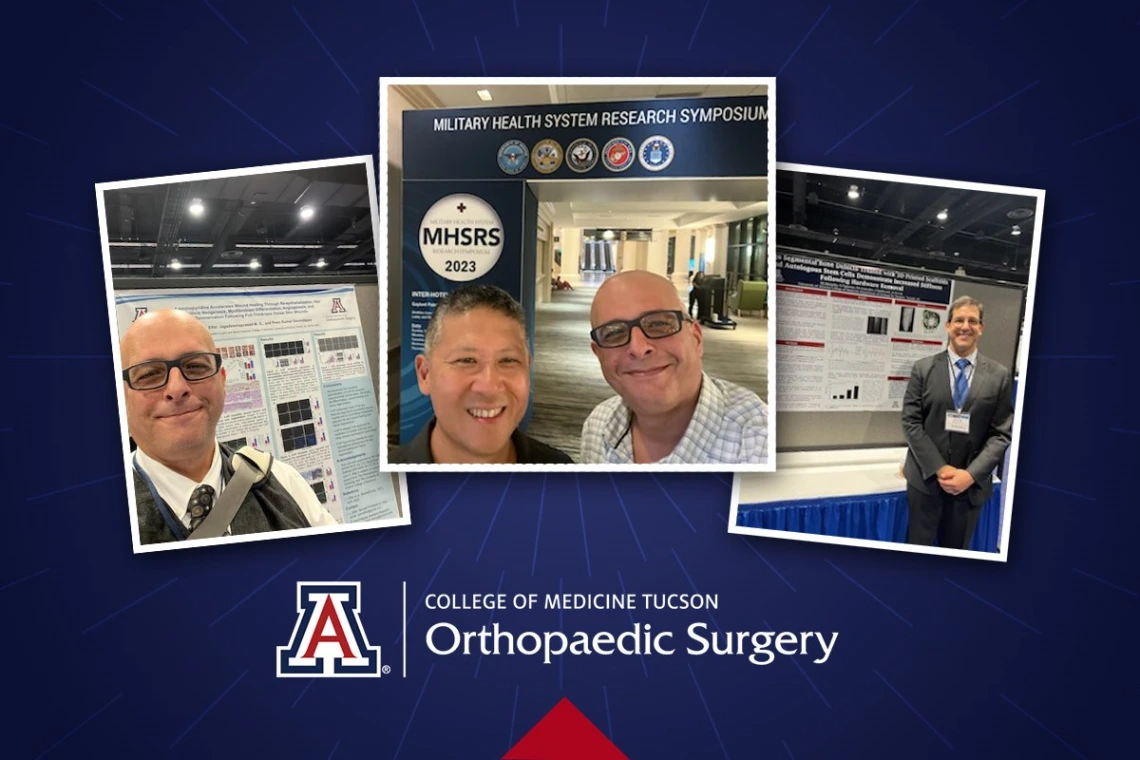Orthopedic Breakthroughs: A Banner Month for Research on Healing Burns, Nerve Injuries & Bone Damage

Researchers in the University of Arizona Department of Orthopaedic Surgery presented groundbreaking work at the DOD Military Health System Research Symposium (MHSRS) Conference in Kissimmee, Florida.
The three highlighted projects – a new treatment for burns and wound healing; a promising demonstration of accelerated healing for nerve injuries; and an innovation for improved bone healing – offer new hope for millions facing these conditions.
The August 2023 event marked the first year UArizona orthopedic scientists have presented two projects at this important annual event.
Burn & Wound Care Research by John C. Elfar, MD.
Military burns and wounds can arise from various causes, including combat-related trauma and non-combat incidents like ammunition handling and gasoline accidents. Burns or wounds disrupt the skin's structural integrity and vital functions such as temperature regulation, fluid balance, and infection protection. The management of skin injuries is challenging due to their complex nature and the lack of regenerative treatments.
Dr. John C. Elfar and his team have been exploring the potential of 4-Aminopyridine (4-AP) as a solution to this problem. In a recent study, Dr. Elfar discovered that 4-AP treatment accelerates skin wound healing by restoring skin architecture, promoting hair follicle growth, and enhancing reinnervation.
The groundbreaking findings have led to a petition to the FDA, aiming to use 4-AP for wound management. Importantly, 4-AP is already used for treating multiple sclerosis and nerve conduction disorders. That status as a drug already approved for other treatments could dramatically shorten approval processes for this new use.
Peripheral Nerve Injury Healing Research by Prem Kumar Govindappa, DVM, PhD
Research by Dr. Prem Kumar Govindappa also explores a new therapeutic potential of erythropoietin (EPO), an FDA-approved treatment for anemia. His groundbreaking study offers the first demonstration of EPO for accelerating nerve function after traumatic peripheral nerve injury (TPNI) by promoting macrophage polarization and phagocytosis.
TPNI destroys axons and Schwann cells (glial cells that wrap around axons of neurons), exacerbating inflammation. The improper phagocytic clearance of dying or dead cell debris affects nerve remodeling, leading to morbidity and incomplete functional recovery. Successful nerve repair relies on the timely transition of macrophage “garbage collectors” from pro-inflammatory (M1) to anti-inflammatory (M2) responses.
Currently, there is a significant need for therapies that can augment the functions of immune cells, such as macrophages (large phagocytes or mobile white blood cells), following TPNI.
Dr. Govindappa tested the effects of EPO on mice with sciatic nerve crush injury. The study showed that EPO treatment under injury stress conditions reduced inflammation and cell death while promoting cellular debris removal by M2 macrophages, remyelination (a nerve-protective insulating layer to restore proper conduction) and tissue repair. His findings may translate to EPO’s utility in early-phase, post-injury treatment to prevent destructive post-traumatic inflammation and promote recovery in the traumatized limb.
Dr. Govindappa also recently received the Orthopaedic Research Pilot Project (ORPP) award to study the benefits of EPO signaling in nerve-mediated limb injury recovery.
View Content from Presentation
Note: Dr. Elfar presented this research at MHSRS on behalf of Dr. Govindappa, who was at the time being presented the ANMS Young Investigator Award at another event.
Bone Healing Research by David Margolis, MD, PhD
Dr. David Margolis presented research addressing another critical issue in orthopedic medicine: significant injuries involving bone loss in long bones (such as the femur, tibia, or humerus) that exceed the body's normal regenerative capacity and often fail conventional treatments.
His work explores the use of biomimetic scaffolds (bone-like support structures) designed to mimic the structure of “spongy bone,” one of two types of bone tissue in the human body. Coating these structures in a special solution that includes calcium particles and stem cells derived from fat tissue dramatically accelerates bone healing.
The stem cell seeded biomimetic scaffolds can bridge a significant gap in bone(a 4.2cm mid-diaphyseal femoral defect) within just three months. Sensors within the scaffolds allow the researcher to monitor bone regeneration in real-time. By nine months, the new bone was strong enough to support the limb, allowing researchers to safely remove supporting hardware.
About the DOD MHSRS Conference
The DOD Military Health System Research Symposium (MHSRS) Conference serves as a critical platform for researchers, medical professionals, and military personnel to collaborate and share cutting-edge developments in healthcare and medicine.
The forum is designed to showcase innovative research for those who can apply it to enhance the health and well-being of military service members and civilians alike. Knowledge and innovations shared at events like MHSRS have the potential to transform lives and redefine medical practices.

